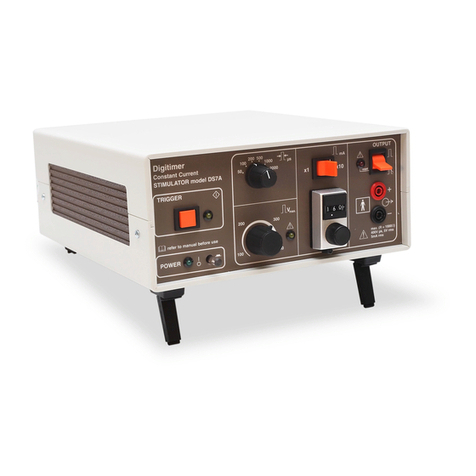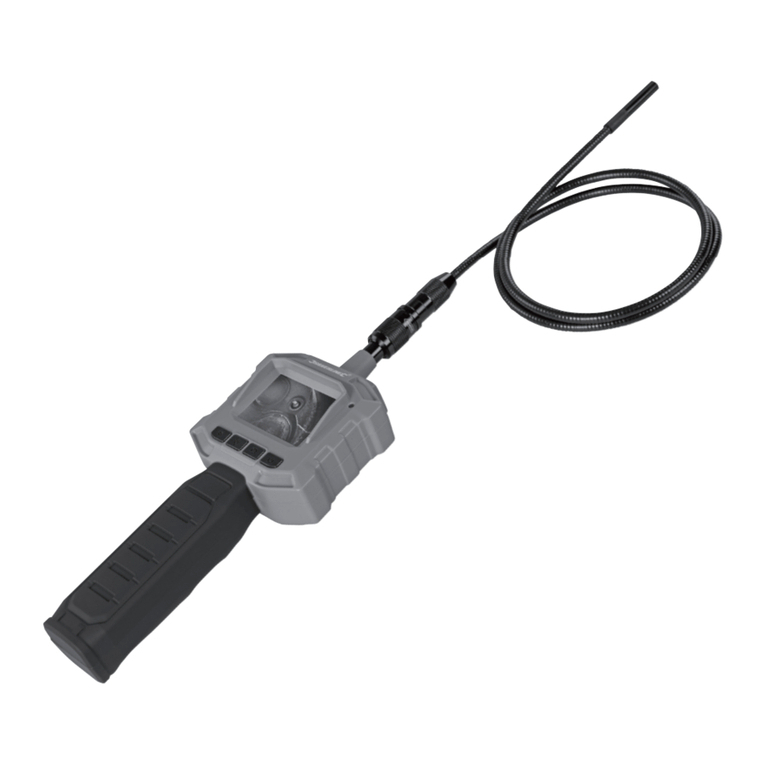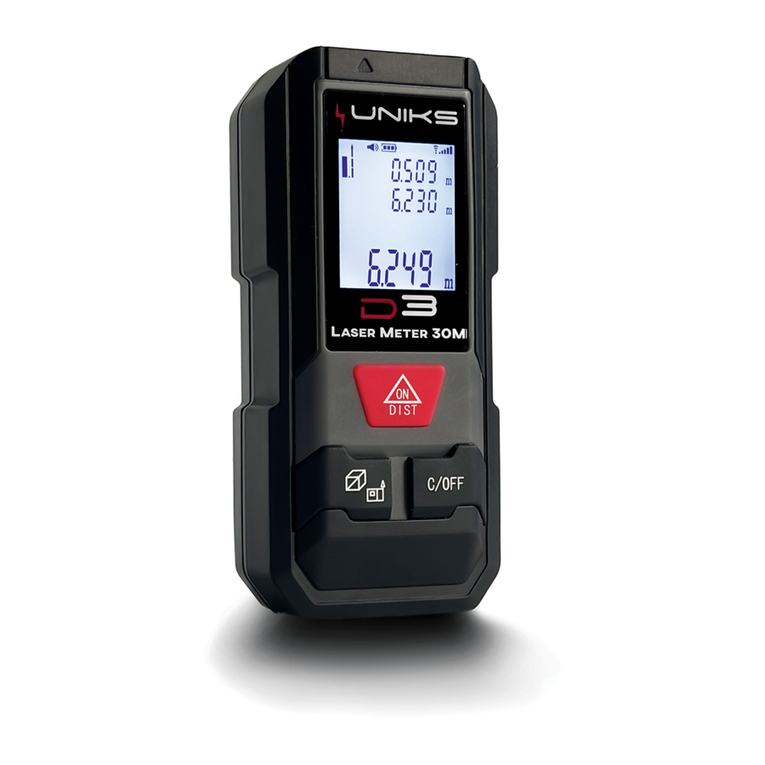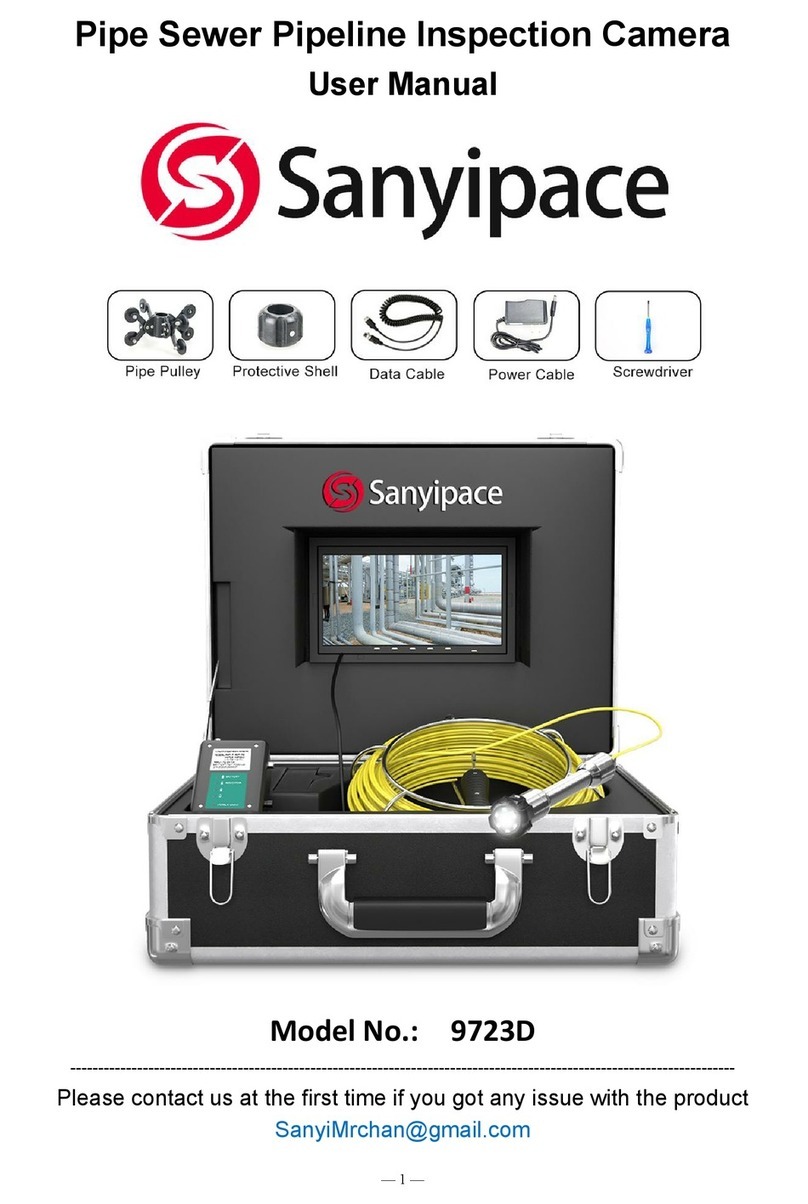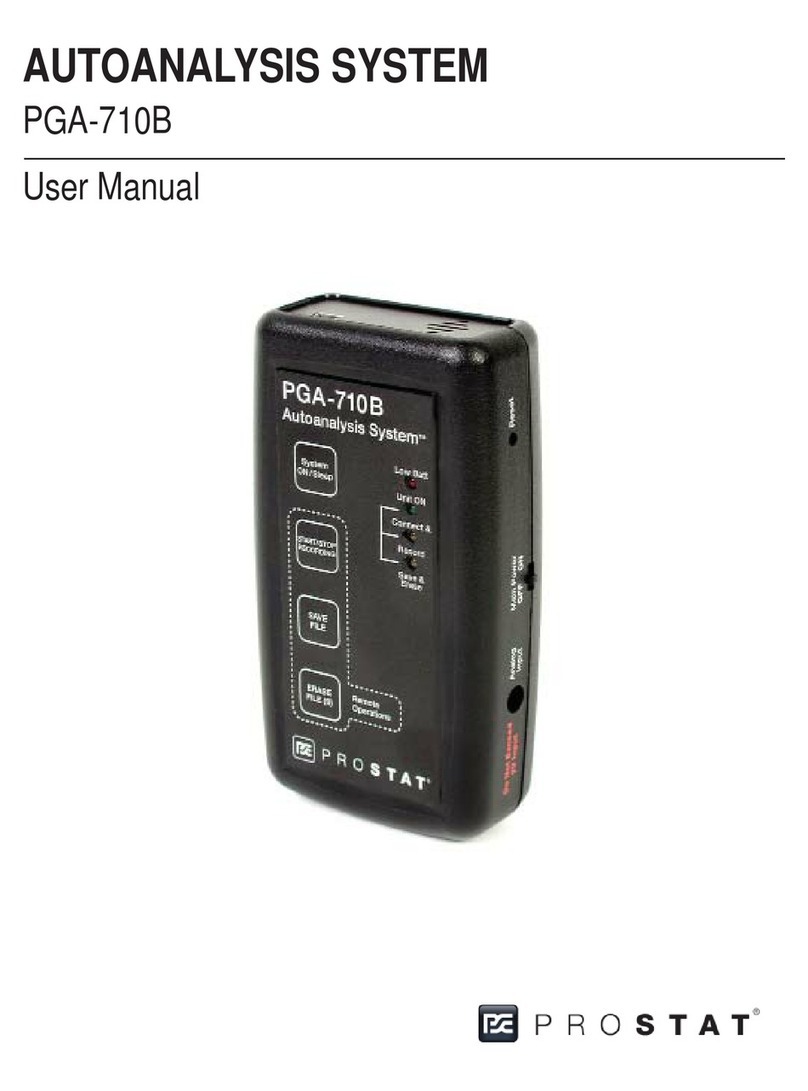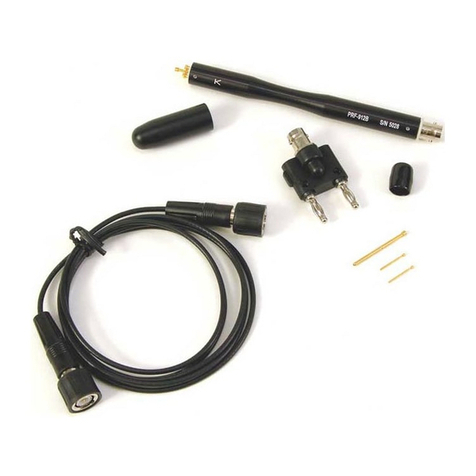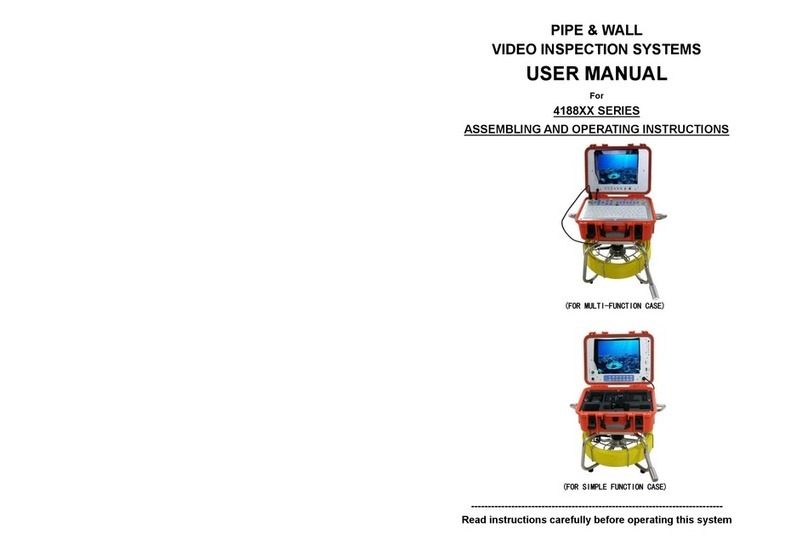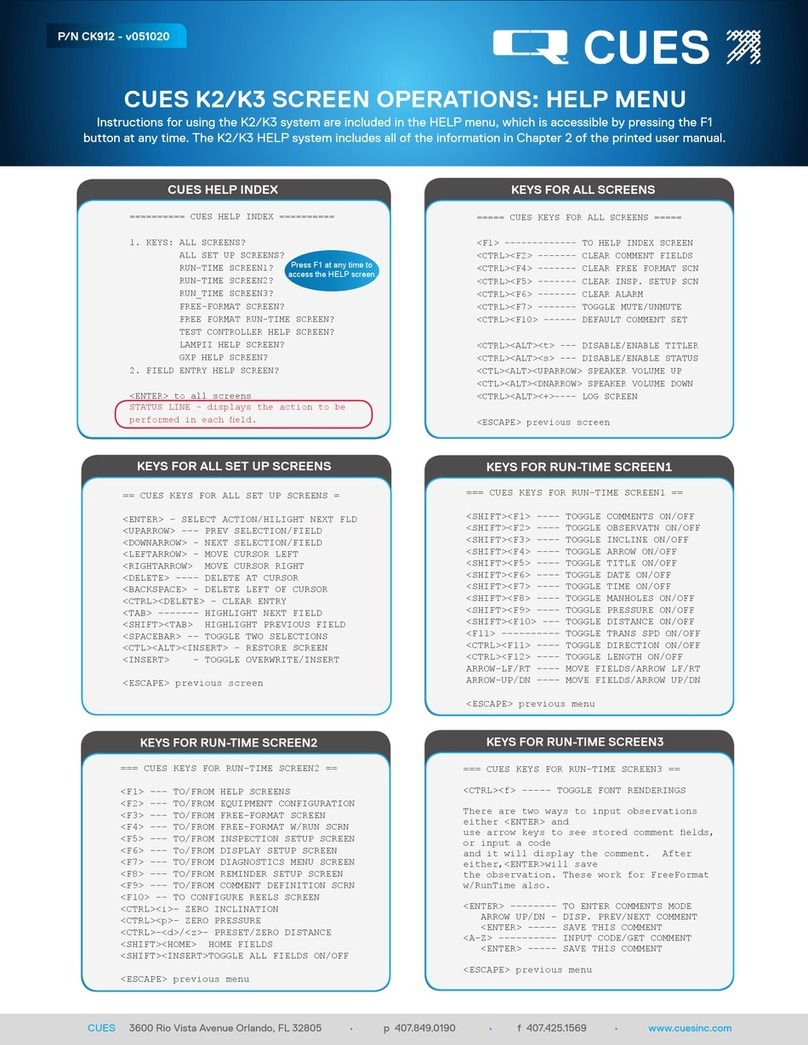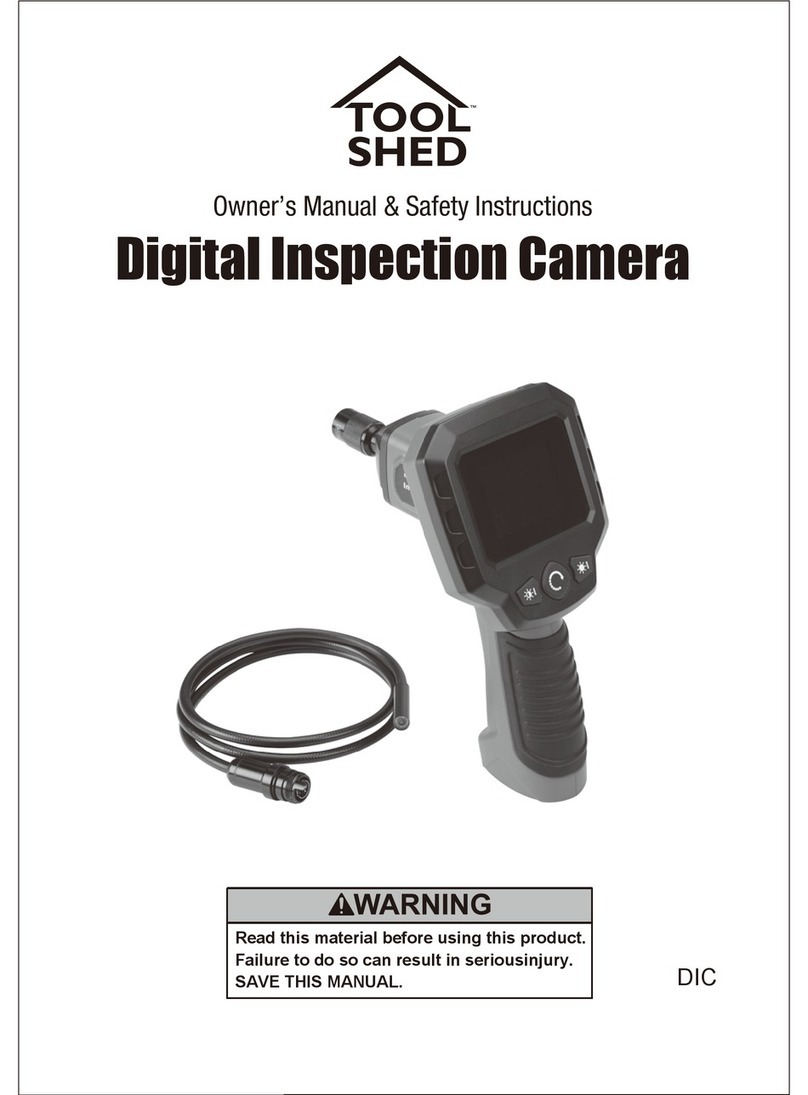Digitimer DS4 User manual

Digitimer DS4
Bi-phasic Stimulus Isolator
OPERATOR'S MANUAL
“Digitimer” is a registered trade mark of Digitimer Limited

DS4 Bi-phasic Stimulus Isolator DS4 Operator's Manual Issue 1.1
Digitimer Ltd. 2 of 21 Copyright 2019
Product Registration
Please take time out to register your new product.
Details are included in the Introduction.
You can even do it online at:-
www.digitimer.com/register

DS4 Bi-phasic Stimulus Isolator DS4 Operator's Manual Issue 1.1
Digitimer Ltd. 3 of 21 Copyright 2019
Table of Contents
Introduction ............................................................................................................. 5
Precautions and Warnings ..................................................................................... 6
Operator’s Manual ............................................................................................ 6
Explosion and Fire ............................................................................................ 6
Damage ........................................................................................................... 6
Moisture .......................................................................................................... 6
Electrical Interference ....................................................................................... 6
Contact Address ................................................................................................... 6
Servicing & Maintenance ....................................................................................... 6
Environmental Considerations ............................................................................... 6
Product Registration ............................................................................................. 7
Why Register your purchase? ............................................................................ 7
How to Register your purchase .......................................................................... 7
Product announcement mailing list .................................................................... 7
Unpacking ............................................................................................................ 7
Included Items ..................................................................................................... 7
Optional Accessories ............................................................................................. 7
Declaration of Conformity ..................................................................................... 8
Functions & Features ................................................................................................ 9
Overview of the Controls/Connections ................................................................... 9
Power Connection ............................................................................................ 9
Power Zone ...................................................................................................... 9
Gate Zone ...................................................................................................... 10
Input Zone ..................................................................................................... 10
Output Zone................................................................................................... 10
Output Characteristics ........................................................................................ 11
Checking Actual Output Current ...................................................................... 12
Output Capacitance and Risetime .................................................................... 12
How Constant is the Constant Current Output?................................................. 12

DS4 Bi-phasic Stimulus Isolator DS4 Operator's Manual Issue 1.1
Digitimer Ltd. 4 of 21 Copyright 2019
Frequency Response ....................................................................................... 12
Inactivity Sensor ................................................................................................ 13
Internal Jumper Selection ................................................................................... 14
Battery Life ........................................................................................................ 15
Battery Testing ................................................................................................... 16
Battery Replacement .......................................................................................... 16
Rack Mounting ................................................................................................... 16
References ............................................................................................................. 17
DS4 Specifications .................................................................................................. 18
Warranty ............................................................................................................... 19
Obtaining Warranty Service ................................................................................. 19
Product change or discontinuation ....................................................................... 19
Operator Notes ...................................................................................................... 20
Index of Figures & Tables
Figure 1 The DS4 Bi-phasic Stiimulus Isolator. ............................................................. 5
Figure 2 Positioning of the DC power supply socket on the DS4. ................................... 9
Figure 3 The POWER zone of the DS4 front panel. ....................................................... 9
Figure 4 The GATE zone of the DS4 front panel. ......................................................... 10
Figure 5 The INPUT zone of the DS4 front panel. ....................................................... 10
Figure 6 The OUTPUT zone of the DS4 front panel. ................................................... 11
Figure 7 Graph of deliverable current (hatched area) depending upon load. ............... 11
Figure 8 Method to monitor current actually delivered. ............................................... 12
Figure 9 Frequency Response Characteristics. ........................................................... 13
Figure 10 Effect of the inactivity sensor on stimulus initiation. .................................... 14
Figure 11 Location of the internal jumpers. ............................................................... 14
Table 1 Expected “Control” battery life. .................................................................... 15
Table 2 Expected “Stimulus” battery life. ................................................................... 15
Figure 12 DS4 battery compartment labelling. ........................................................... 16

DS4 Bi-phasic Stimulus Isolator DS4 Operator's Manual Issue 1.1
Digitimer Ltd. 5 of 21 Copyright 2019
Introduction
The DS4 has been developed to meet the needs of laboratory scientists who require a stimulus isolator that
can output a bi-phasic isolated constant current stimulus in response to an external analogue command voltage
signal, provided by a computer DAC via software or a signal generator. Such a requirement is already met by
our NeuroLog System in the form of the NL512 Biphasic Buffer and NL800A Stimulus Isolators, but the DS4
provides our first standalone device to meet this need.
The DS4 accepts a variety of voltage input ranges (±1V, ±2.5V, ±5V and ±10V) and produces a constant
current stimulus output in 4 overlapping ranges (±10µA, ±100µA, ±1mA and ±10mA) from a compliance
voltage of approximately ±44V. In addition, the DS4 has a GATE input which allows multiple DS4's to be
connected to a single analogue voltage source, with each DS4 being digitally enabled, separately.
One of the problems with stimulators that make use of an external voltage source to define a stimulus
waveform is that small offsets or noisy baseline signals from the DAC's used to drive them can result in
unwanted battery drain or perhaps worse, low amplitude stimulation. The DS4 uses a special "inactivity
sensor" to monitor the input voltage and disable the DS4 output if this voltage falls below 0.15% of the full
scale value (in -ve or +ve directions) for a user selectable time period of 100ms, 200ms, 1s or 2s. Unlike
other devices which only produce an output when the input voltage exceeds a threshold value, this "inactivity
sensor" reduces battery usage and damaging "leak currents" during infrequent stimulation, while at the same
time maintaining low levels of zero crossing distortion for repetitive waveforms.
The DS4 uses an external power supply to power the input control circuitry and readily available/inexpensive
batteries to provide the opto-isolated stimulus voltage source. Batteries are only used when a stimulus is
commanded by an input voltage waveform.
Figure 1 The DS4 Bi-phasic Stiimulus Isolator.

DS4 Bi-phasic Stimulus Isolator DS4 Operator's Manual Issue 1.1
Digitimer Ltd. 6 of 21 Copyright 2019
Precautions and Warnings
Operator’s Manual
Carefully study this Operators Manual before using the DS4 Bi-phasic Stimulus Isolator.
Explosion and Fire
The DS4 must not be used in an explosive atmosphere or volatile atmosphere.
Damage
The DS4 and/or any accessories must not be used if there are any signs of external damage.
Moisture
The DS4 and/or any accessories must not be used if any parts are wet or damp.
Electrical Interference
This unit has been fully tested for European (CE) EMC conformity. This unit should NOT be used near radio
transmitters. If any ‘strange’ behaviour of the unit is noted, discontinue use immediately and refer to a qualified
EMC engineer.
Contact Address
Digitimer Limited
37 Hydeway
Welwyn Garden City
AL7 3BE
UK
Telephone:- (UK) 01707 328347 (Int.) +44 1707 328347
Fax:- (UK) 01707 373153 (Int.) +44 1707 373153
E-mail:- sales@digitimer.com or technical@digitimer.com
Website:- www.digitimer.com
Servicing & Maintenance
This equipment does not require any regular maintenance but if you would like your DS4 to be serviced we
are happy to do so. Please contact us for a reference number and instructions before despatching the unit.
Before each use - The case and all interconnecting cables should be inspected for any damage. The equipment
(or the lead) should be sent for repair if any damage is found.
Environmental Considerations
The European Union has adopted Directive 2002/96/EC on Waste Electrical and Electronic Equipment (WEEE),
with requirements that went into effect August 13, 2005. WEEE is intended to reduce the disposal of waste
from electrical and electronic equipment by establishing guidelines for prevention, reuse, recycling and
recovery.
As part of our legal obligation, Digitimer Limited is a registered EEE producer. Our WEEE registration number
is WEE/BJ0052TQ. For further information relating to the correct method of disposal of any of our equipment,
which features this label , please contact us.

DS4 Bi-phasic Stimulus Isolator DS4 Operator's Manual Issue 1.1
Digitimer Ltd. 7 of 21 Copyright 2019
Product Registration
For a speedy response to all your questions now and in the future, please take time out to register your new
DS4 at www.digitimer.com/register now! Product registration permits us to quickly advise you of any safety
matters or new product information. This web address is your point of contact for all questions regarding the
DS4. The site’s contents are now growing rapidly, so please bookmark it so that you visit it regularly to check
out the new items.
Why Register your purchase?
Digitimer Limited periodically offers enhancements and updates to our products. Without product
registration, users of our products may miss out on announcements of important enhancements to
the products that they are using
Digitimer Limited does not make our customer list available to anyone else. Any information that you
provide to us is strictly confidential.
How to Register your purchase
Product registration can be accomplished in two ways. You may fill out and mail in the product
registration/warranty card supplied with each Digitimer Limited product. You may also register on-line at our
www.digitimer.com/register website.
Product announcement mailing list
Digitimer Limited has e-mailing lists which we use as our primary outlet for announcements of new products,
product enhancements and product updates. We strongly recommend that all users of our products sign up
for the list that is most appropriate to their area of interest. E-mail is kept to a minimum and list membership
is kept in the strictest confidence. Only Digitimer Limited can send mail to members of our e-mailing lists.
You may join the DS4 mailing list through our www.digitimer.com/register website.
Unpacking
After unpacking the DS4 Bi-phasic Stimulus Isolator from the shipping carton, please inspect it for any sign of
shipping damage. Please contact the carrier and your Distributor, or Digitimer Limited, immediately if there is
any damage. Do not dispose of the shipping carton. The carrier will want to examine the shipping carton to
process a damage claim. Digitimer Limited and their Distributors insure all shipments to cover shipping
damage.
It is also advisable to keep the shipping carton in the event that the instrument needs to returned for service.
Included Items
DS4 Bi-phasic Stimulator
±15V DC Power Supply (input requirements 110-220VAC)
Mains lead
Pair of output plugs (NL985P)
Operator's Manual (this document)
Optional Accessories
Digitimer can supply extra sets of output plugs (NL985P) for user connection to stimulating electrodes, as well
as 1.5m BNC cables (D185-TC3). We also stock sets of the ten batteries (DS4-BATT) which provide the
output power source for the stimulator. One or two stimulators may be mounted in a 19" rack using a specially
fabricated frame (model D121-11).

DS4 Bi-phasic Stimulus Isolator DS4 Operator's Manual Issue 1.1
Digitimer Ltd. 8 of 21 Copyright 2019
Declaration of Conformity

DS4 Bi-phasic Stimulus Isolator DS4 Operator's Manual Issue 1.1
Digitimer Ltd. 9 of 21 Copyright 2019
Functions & Features
Overview of the Controls/Connections
Power Connection
The DS4 control circuitry is powered by the supplied ±15V DC power supply adaptor which must be connected
to the DS4 via the socket illustrated in Figure 2. The supplied mains lead should then be used to connect the
DC power supply adaptor to a suitable mains supply (110-220V AC). Once all connections have been made,
the mains socket and the DS4 can be switched on.
Figure 2 Positioning of the DC power supply socket on the DS4.
Note that the DS4 is NOT a re-chargeable unit and the DC power supply must remain connected
and switched on while the DS4 is in use.
Power Zone
The DS4 has a POWER switch in the middle of the front panel which switches the unit on or off (by
disconnecting the DC power supply). When the power is switched on (toggle switch up), the green LED is lit.
It is recommended that the DS4 is switched off when not in use, as significant battery drain will occur if a
voltage continues to be applied at the INPUT, when the DS4 is switched on.
Figure 3 The POWER zone of the DS4 front panel.
DC Power Supply
Input Socket

DS4 Bi-phasic Stimulus Isolator DS4 Operator's Manual Issue 1.1
Digitimer Ltd. 10 of 21 Copyright 2019
Gate Zone
A BNC socket is provided to allow a TTL command to “Gate” the output on or off. This feature means that a
command voltage signal can be applied continuously at the INPUT and the stimulus turned on and off via
digital control at the GATE input. Further, a single command voltage can be applied to multiple DS4 units with
individual digital lines used to turn specific DS4 outputs on or off.
A toggle switch is provided which enables (UP) or disables (DOWN, labelled OFF) the stimulus output. The
amber LED is lit when both the GATE is switched on (toggle switch up) and a TTL high input is being applied
at the GATE input (or this input is open circuit), indicating that the output is enabled. The maximum voltage
that can be applied at the GATE input is ±15V.
IMPORTANT NOTE: Even if the GATE input is disconnected, the GATE toggle switch must be in the UP
position for the DS4 to deliver a stimulus.
Figure 4 The GATE zone of the DS4 front panel.
Input Zone
A command voltage waveform is applied at this BNC socket and is used by the DS4 to determine the shape of
the stimulus it delivers. The DS4 accepts various input voltage ranges, but is factory set to ±10V. An internal
jumper allows the operator to change the input voltage range to ±1V, ±2.5V or ±5V to match the output
range available from the signal generator being used. Please refer to Internal Jumper Selection for further
details. If the input voltage range is changed, this should be indicated by placing a marking in the appropriate
box on the front panel. The maximum voltage that can be applied at this input is ±12V.
The INPUT zone of the DS4 front panel includes a pair of amber LEDs which illuminate when the input voltage
exceeds +0.15% or -0.15% of the full scale voltage.
Figure 5 The INPUT zone of the DS4 front panel.
Output Zone
The OUTPUT zone of the DS4 front panel includes a pair of 2mm touch proof sockets and a range selector
switch which allows the operator to adjust the output current range from ±10µA to ±10mA, from the
compliance voltage source of ±44V. If the DS4 is set to an input voltage range of ±10V and the output range
dial is set to ±10mA, then a +10V signal at the input will deliver +10mA at the output and +5V will deliver
+5mA etc.

DS4 Bi-phasic Stimulus Isolator DS4 Operator's Manual Issue 1.1
Digitimer Ltd. 11 of 21 Copyright 2019
Figure 6 The OUTPUT zone of the DS4 front panel.
Stimulation electrodes should be connected to the DS4 via the pair of NL985P plugs which are supplied with
the DS4.
Output Characteristics
As with use of any electrical stimulator, the operator should be familiar with Ohm's Law (V=IR) and check that
the stimulation pathway is of low enough impedance to allow the required current to pass through the
preparation. For example, if a stimulus of up to ±10mA is required, then the compliance voltage ±44V would
be able to pass this current through an impedance of no more than 4.4kohms.
Bear in mind that electrodes in tissues do not behave as resistors - they may have much lower effective series
resistance for narrow pulses than for DC inputs, due to polarisation (most metal electrodes polarise with DC
inputs). A typical tungsten microelectrode, for example, has a DC resistance of about 200Mohms, an
'impedance' of 1Mohm for 1kHz sine input, and an impedance of perhaps only 100kohm for a 100µs pulse, a
2000:1 ratio. Figure 7 predicts that this electrode will pass about 400µA for short pulses, but only about 0.2µA
for very long pulses.
Figure 7 Graph of deliverable current (hatched area) depending upon load.

DS4 Bi-phasic Stimulus Isolator DS4 Operator's Manual Issue 1.1
Digitimer Ltd. 12 of 21 Copyright 2019
Checking Actual Output Current
If there is some doubt that the load resistance is low enough to allow operation within the shaded portion of
Figure 7, the actual output current can be monitored by inserting a 1kohm resistor into the stimulation pathway
as illustrated in Figure 8.
Note that the 1kohm monitoring resistor is connected directly to the preparation ground; this obviously reduces
the effective isolation of the DS4 output, which is not normally desirable. All of the output current must
however pass through both the 1kohm resistor and the electrode (load resistance), giving an accurate measure
on the oscilloscope of the actual output current. The oscilloscope input cannot be put directly across the
isolator output because it would then shunt the electrode. The 1kohm series resistor does not contribute
appreciably to the total load resistance for high impedance electrodes such as microelectrodes; gross
electrodes (e.g. EEG electrode, silver hooks, etc.) may require a smaller series resistor (e.g. 10 ohms) when
high output currents are used.
Figure 8 Method to monitor current actually delivered.
Output Capacitance and Risetime
The DS4 has a total output capacitance of approximately 40pF. Thus a 1Mohm resistor across the output will
limit the output risetime to about 40µs. As discussed above, however, metal microelectrodes which are
nominally characterised as having an impedance of 1Mohm (at 1kHz) behave more like 100kohms resistors
for short pulses and therefore usually produce risetimes of the order of 10 to 15µs. Non-polarisable electrodes
(chlorided silver electrodes, micropipettes) behave more like resistors than ordinary metal microelectrodes do;
i.e. their impedance is more constant as a function of frequency. Thus, a 10Mohms micropipette acts like a
10Mohms resistor for short pulses as well as long ones. The risetime may therefore be quite long for these
electrodes (approximately = 40µs electrode DC resistance in Mohms).
How Constant is the Constant Current Output?
The DS4 has more than 900Mohms output resistance at its output terminals. Thus, load resistance variations
from a short circuit (0 ohms) to 100Mohms will result in only approximately a 10% variation in output current
(assuming that the voltage drop through the load does not exceed the 44V limit discussed above). Obviously
few load situations will vary to this extent, and for all practical purposes, the output is constant.
Frequency Response
DS4

DS4 Bi-phasic Stimulus Isolator DS4 Operator's Manual Issue 1.1
Digitimer Ltd. 13 of 21 Copyright 2019
Figure 9 illustrates the frequency response characteristics of the DS4 when a ±5V input is applied with the
DS4 set to a maximum input range of ±10V, an output range of ±10mA and a load of 1kohm. The graph
shows that the -3dB roll-off is at 50kHz, while the expected DS4 output is constant for frequencies up to 5kHz.
Figure 9 Frequency Response Characteristics.
Inactivity Sensor
One of the problems with stimulators that make use of an external voltage source to define a stimulus
waveform is that small offsets or noisy baseline signals from the DAC's used to drive them can result in
unwanted battery drain or perhaps worse, low amplitude stimulation. The DS4 uses a special "inactivity
sensor" to monitor the input voltage and disable the DS4 output if this voltage falls below 0.15% of the full
scale value (in -ve or +ve directions) for a user selectable timeout of 100ms, 200ms, 1s or 2s. Unlike other
devices which only ever produce an output when the input voltage exceeds a threshold value, this "inactivity
sensor" reduces battery usage and damaging "leak currents" during infrequent stimulation, while at the same
time maintaining low levels of zero crossing distortion for repetitive waveforms.
The inactivity sensor timeout can be adjusted between the four possible settings using on board jumpers
which are accessible from the battery compartment. Please refer to Internal Jumper Selection for further
details.
It is important to note that the inactivity sensor will result in a slight “glitch” in the stimulus waveform when
the DS4 is first used after a period of inactivation. This is because the inactivity sensor prevents any output
until the command input voltage exceeds ±0.15% of the full scale.

DS4 Bi-phasic Stimulus Isolator DS4 Operator's Manual Issue 1.1
Digitimer Ltd. 14 of 21 Copyright 2019
Figure 10 Effect of the inactivity sensor on stimulus initiation.
The example illustrated in Figure 10 shows how the first upward section of a saw tooth waveform (or any
similar slowly changing voltage) will have a small distortion at the initiation of the waveform (indicated by the
purple circle), but that this distortion is absent in the second and subsequent cycles because the inactivity
sensor has not been re-enabled. Clearly, if the slope of the input voltage waveform is very shallow and the
timeout setting for the inactivity sensor is short, it is quite possible that the inactivity sensor could reactivate
and the “glitch” could repeat. This may be prevented by increasing the duration of the timeout setting or
using a steeper waveform shape.
Internal Jumper Selection
The DS4 has two sets of jumpers for (i) input voltage range and (ii) inactivity sensor timeout that can be set
by the operator. To gain access to the battery compartment, it is first of all necessary to remove the two
screws which hold the cover in place and lift it away from the body of the stimulator. On the right hand side
of the battery compartment are two sets of jumpers. The upper set controls the inactivity sensor timeout,
while the lower set defines the input voltage range. The battery compartment cover (see Figure 12) includes
labelling which indicates jumper positioning.
Figure 11 Location of the internal jumpers.
Inactivity Timeout
(set to 2s)
Input Voltage
Range (set to 10V)
Input Voltage
Output Current
±0.15% of
full scale
input voltage

DS4 Bi-phasic Stimulus Isolator DS4 Operator's Manual Issue 1.1
Digitimer Ltd. 15 of 21 Copyright 2019
Battery Life
The ten batteries in the DS4 discharge ONLY when a voltage is applied at the input and battery
drain between commanded stimuli is negligible due to the presence of the Inactivity Sensor.
These ten batteries are divided into two sets of five for each polarity phase (a single “Control” battery and
four “Stimulus” batteries). The life of “Control” batteries is determined solely by the amplitude and duration
of the input pulses and not the output amplitude: continuous operation with high duty cycles at the maximum
input amplitude, produces greater battery drain than low duty cycles at low input amplitudes. The drain on
this battery is the same for each output range.
Input Voltage (V) Duty Cycle Life (hours)
10 50.00% 25
10 10.00% 125
10 1.00% 1250
5 50.00% 50
5 10.00% 250
5 1.00% 2500
1 50.00% 250
1 10.00% 1250
1 1.00% 12500
Table 1 Expected “Control” battery life.
The four “Stimulus” batteries simultaneously discharge at a rate that depends only on the magnitudes of the
output pulses. The table below gives a rough guide to the service life for these batteries.
Pulse
Amplitude
Duty
Cycle
Life to 80%
(~34.4V output)
Life to 50%
(~22V output)
10mA 50.00% 8 hours 16 hours
10mA 10.00% 40 hours 80 hours
10mA 1.00% 400 hours 800 hours
1mA 50.00% 80 hours 160 hours
1mA 10.00% 400 hours 800 hours
1mA 1.00% 4000 hours 8000 hours
Table 2 Expected “Stimulus” battery life.
As the “Stimulus” batteries discharge, their output voltage decreases. The first number in the Life entries
above indicate the service at which the battery voltage in each battery has fallen to 80% (giving a total output
voltage available of about 34.4V); the second number indicates the hours of service to battery voltages of
about 50% (total output voltage available of about 22V).

DS4 Bi-phasic Stimulus Isolator DS4 Operator's Manual Issue 1.1
Digitimer Ltd. 16 of 21 Copyright 2019
Thus, with fresh batteries, the DS4 will be able to deliver ±10mA through any load resistance less than
4.4kohms, but after 8 hours of continuous service with a 50% duty cycle at the maximum amplitude setting
on the 10mA output range, only 7.8mA can be delivered through the 4.4kohms load (i.e.
34.4V/4,400=0.0078A). In situations where high currents are required and load resistances are near the
limits, careful attention must be paid to battery checks and replacement.
In most applications, the entire set has a life of several months, perhaps even approaching the battery shelf
life. As the cost of these batteries is relatively low, it is wise to replace all 10 at the same time.
Battery Testing
The DS4 is equipped with battery test sockets which allow the operator to test the status of the batteries
without removing them from the unit. Battery voltages can be tested using a digital multimeter, by placing
the probes into the labelled test sockets for the +ve and -ve phase and control batteries.
It is important to test the batteries while the DS4 is delivering a long stimulus, so that failing batteries can be
more readily identified.
Battery Replacement
If replacement is necessary, the ten batteries are located under the cover panel in base of the unit. Removal
of the two screws in the panel will give access.
It is imperative that the batteries are fitted with the correct polarity orientation. This is marked on the battery
holders and the cover panel (see Figure 12). The symbols must match.
It is recommended that all ten batteries are replaced at the same time. Sets of replacement batteries are
available from Digitimer, using the part code DS4-BATT.
Figure 12 DS4 battery compartment labelling.
Rack Mounting
The DS4 can be mounted and positioned on any plane and 19” rack mounting is possible by using two of the
box fixing screws (diagonal corners) through our D121-11 Mounting Frame, which is available from Digitimer
or our representatives. The mounting frame allows any two of our DG2A, DS2A, DS3 or DS4 devices to be
positioned side by side.

DS4 Bi-phasic Stimulus Isolator DS4 Operator's Manual Issue 1.1
Digitimer Ltd. 17 of 21 Copyright 2019
References
As the DS4 is a brand new product we do not yet have any publications that cite its use. However, if you
publish research which has used the DS4, please cite it in your methods section to help other researchers.
Digitimer would appreciate a copy of any relevant publications and could add details to this section of the
manual.

DS4 Bi-phasic Stimulus Isolator DS4 Operator's Manual Issue 1.1
Digitimer Ltd. 18 of 21 Copyright 2019
DS4 Specifications
Output: Bi-phasic constant current proportional to the input voltage
Output Ranges: ±10µA; ±100µA; ±1mA; ±10mA for a full scale input
Output Duration: >2µs
Compliance: ±44V from 8x GP23A batteries
Linearity: ±3% of full scale output for each output range
Output Impedance: >900Mohms
Output Rise Time: <5µs (1kohm load), <40µs (1Mohm load)
Inputs:
IN: Ranges: ±1; ±2.5; ±5; ±10V full scale (selected by an internal jumper)
with a limit of ±12V max. without damage.
Input Impedance: 1Mohm
GATE: Range: TTL; Gate OFF if Low; Gate ON if High or open circuit. Limit of
±15V max. Input Impedance: 10kohm
Inactivity Sensor: The output is disabled if the voltage input remains below 0.15% of the full-
scale value (-ve or +ve phases) for a user selectable period of 100ms,
200ms, 1s or 2s. This time period can be adjusted with an internal jumper.
Connections: Output - 2mm shrouded, TP sockets (red and black) spaced at 0.75"
Input - Front panel BNC socket
Gate - Front panel BNC socket
Battery Test - Six 2mm sockets
Power - Socket for external power supply
Controls: Gate - On/Off toggle (Off overides BNC input)
Output Range - 4 position rotary switch
Power - On/Off toggle switch
Indicators:
Power ON LED Green (lit when the power supply is connected and DS4 is switched On)
Gate Enabled LED Amber (lit when Gate is On and the Gate Input is held TTL high or open
circuit)
Phase +ve LED Amber (lit when input exceeds +0.15% of full scale voltage)
Phase -ve LED Amber (lit when input exceeds -0.15% of full scale voltage)
Power: Included external power supply (input voltage 110V - 220V) providing ±15V
DC output.
10 x 12V GP23A Batteries.
Mounting: One or two stimulators may be mounted in a 19" rack using a specially
fabricated frame (model D121-11) available from Digitimer Ltd.
Dimensions: 190 x 110 x 80 (w x h x d)
Weight: 500g (approx.)

DS4 Bi-phasic Stimulus Isolator DS4 Operator's Manual Issue 1.1
Digitimer Ltd. 19 of 21 Copyright 2019
Warranty
Digitimer Limited warrants to the first purchaser, for a period of one year from the date of purchase, that this
Digitimer Instrument (hereafter referred to as the “Product”) will be free from defective workmanship and
materials, and agrees that it will, at its option, either repair the defect or replace the defective Product or part
thereof at no charge to the purchaser for parts and labour. The Product must be returned to Digitimer Limited,
carriage paid and insured.
Digitimer Limited will return the Product, carriage paid and insured, in the most appropriate method as
determined by Digitimer Limited. If a faster shipping service is desired by the customer, any additional special
delivery expenses must be paid by the customer.
This warranty does not apply to shipping damage. Digitimer Limited fully insures all shipments. Any claims
of damage upon receipt must be filed with the carrier and Digitimer Limited immediately. This warranty does
not apply to any exterior appearance item of the Product which has been damaged or defaced, which has
been subjected to misuse and abuse, abnormal service or handling, or which has been altered or modified in
design or construction.
This warranty does not apply to any interconnection cables supplied with the Product.
This warranty does not apply if any unauthorised repairs, modifications or alterations have been made to the
Product.
This warranty applies to software products only to the extent of maintenance release software to correct
improper operation of the Product. Software updates to increase the capabilities of the present product are
not to be provided under the terms of this warranty. Updates will be sent at no cost to the customer by
normal common carrier routes. If faster delivery is desired, the customer must assume any additional
expenses for special delivery service.
No sales organisations, other than Digitimer Limited itself, are authorised to make any warranties other than
those described above, or to extend the duration of any warranties beyond the time period described above
on the behalf of Digitimer Limited. If Digitimer Limited agrees to such a modification of this warranty, Digitimer
will furnish a modified copy of this agreement, which must be presented if a claim is being made under these
modified terms.
Obtaining Warranty Service
Warranty service of this Product can be obtained by returning the Product, carriage paid and insured, to
Digitimer Limited, or the Distributor from whom the equipment was purchased. Prior authorisation before
shipping the product is advised for the most expedient service.
Product change or discontinuation
Digitimer reserve the right to discontinue any instrument or to change its specification without notice, and
without responsibility for incorporating changes in instruments already sold.

DS4 Bi-phasic Stimulus Isolator DS4 Operator's Manual Issue 1.1
Digitimer Ltd. 20 of 21 Copyright 2019
Operator Notes
Please use the space below to make notes on particular settings or include any warranty information or service
history for your DS4.
Table of contents
Other Digitimer Analytical Instrument manuals
Popular Analytical Instrument manuals by other brands

Gigahertz Solutions
Gigahertz Solutions NFA 30M operating manual

Spartan Tool
Spartan Tool SparVision 200 owner's manual
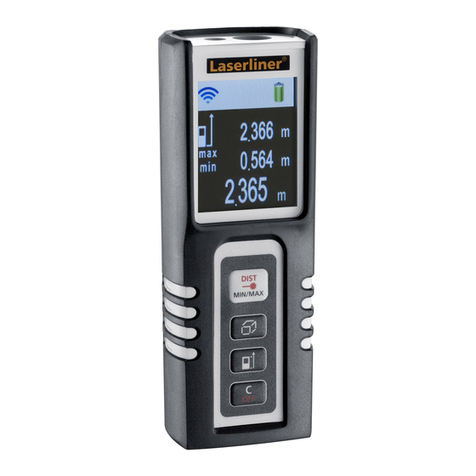
LaserLiner
LaserLiner DistanceMaster Compact Pro manual
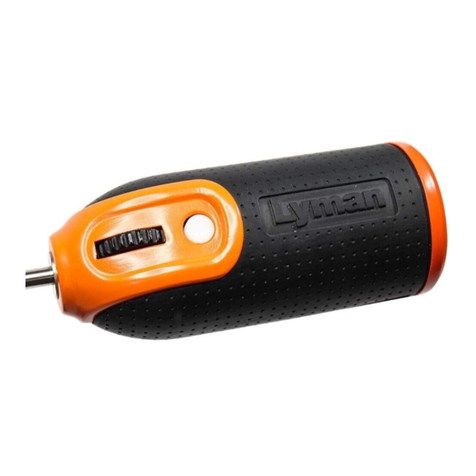
Lyman
Lyman Borecam PRO Operation instructions
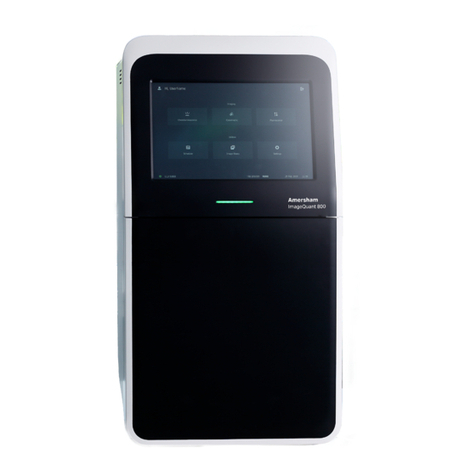
cytiva
cytiva Amersham ImageQuant 800 user manual

OPTICOM
OPTICOM OPERA CONTROL CENTER SERVER - V 3.5 user manual
